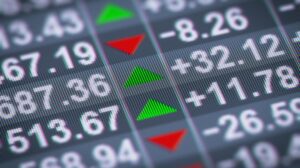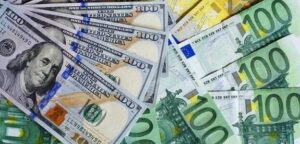
Most stock indices of Western European countries are moderately declining on Thursday, investors appreciate a large number of quarterly reports of large European companies.
In addition, market participants are waiting for the results of the October meeting of the European Central Bank. The ECB is expected to raise key interest rates again by 75 bp.
The European Central Bank is constrained from refusing to raise significant interest rates anytime soon as eurozone consumer price growth is likely to have not peaked yet, Mark Dowding, chief investment officer at BlueBay Asset Management, told Dow Jones.
The composite index of the largest companies in the Stoxx Europe 600 region decreased by 0.22% by 11:27 a.m. and amounted to 409.42 points.
The German DAX fell 0.2%, as did the French CAC 40. The Italian FTSE MIB and the Spanish IBEX 35 shed 0.3% and 0.5%, respectively. Meanwhile, the British stock index FTSE 100 added 0.3%.
Shares of Credit Suisse Group AG plunged 11%. The Swiss bank announced the placement of new shares worth up to 4 billion francs ($4.07 billion) and the sale of part of the investment business, and also announced a likely reduction in staff by 9 thousand employees. The cost of the reorganization will amount to about $2.9 billion over two years.
In addition, on Thursday, Credit Suisse released its financial statements for the third quarter. The bank’s net loss in July-September amounted to 4.03 billion Swiss francs ($4.09 billion) against a profit of 434 million francs a year earlier. Quarterly revenue fell by 30% to 3.8 billion francs.
The price of TotalEnergies securities is growing by 2.1%. The French oil and gas company increased its net profit by 43% year-on-year in the last quarter thanks to higher oil and natural gas prices.
Shell capitalization increases by 3.3%. The British-Dutch energy giant cut third-quarter net income by almost three times from the previous quarter, but the adjusted figure was better than market forecasts.
The market value of Deutsche Lufthansa AG is growing by 1.6%. The airline posted a net profit in the last quarter, almost doubled its revenue and announced its recovery from the pandemic crisis.
Lloyds shares are down 1.3% after the British bank reported a 26% decline in pre-tax profit in the third quarter, to 1.51 billion pounds, due to write-offs due to worsening macroeconomic forecasts.
Shares of Banco de Sabadell shed 0.5%, although the Spanish bank increased quarterly net profit to 317 million euros from 149 million euros a year earlier and approved an increase in the dividend payout rate to 40% of profit.
Unilever shares are down 0.1% in London on Thursday and 0.2% in Amsterdam. One of the world’s leading FMCG suppliers increased its turnover by 17.8% last quarter as higher prices offset lower sales volumes.
Meanwhile, on Thursday it became known that the leading index of German consumer confidence in the country’s economy rose slightly from a historic low.
The November indicator, calculated by the research company GfK, was minus 41.9 points compared to the revised minus 42.8 points in October, which generally coincided with experts’ expectations. The index rose for the first time in five months.
The value of the indicator fell to minus 42.5 points compared to minus 36.8 points in September. A record low is recorded following the results of the fourth month in a row. Analysts on average predicted a less significant drop – to minus 39 points, according to Trading Economics.
Meanwhile, Spain’s third-quarter unemployment rate rose to 12.67% from 12.48% a quarter earlier.

On the night of October 27, Russian invaders damaged energy infrastructure facilities in the Kyiv region, a number of critical facilities were put out of action, head of the Kyiv regional military administration Oleksiy Kuleba said.
“It is necessary to prepare for emergency power outages for an indefinite period. Specialists are taking the necessary measures to eliminate the consequences of the shelling. Everyone is working in their places non-stop,” Kuleba wrote on his Telegram channel.
He urged residents of the region to consume electricity moderately, especially during peak hours.
“This is a forced step to stabilize the situation,” the head of the OVA stressed.

The Belgian NGO APOPO trains rats to search for people trapped under rubble, such as after earthquakes or hurricanes.
Previously, APOPO spent more than a decade at its base in Tanzania training dogs and Gambian hamster rats to search for mines and identify those infected with tuberculosis. The idea of rescue rats at APOPO had been nurtured for years, but the NGO lacked funding and a partner. The new project was launched in April 2021.
“Usually rats are quite curious, like to scout the area, and this is the most important thing for search and rescue operations,” said project leader scientist Donna Keane.
The rats are trained to search for survivors in an environment depicting a disaster area. Rodents are equipped with a high-tech “pack” that is attached to their body with a neoprene vest: after the rat finds the desired object in the room, it must pull the lever, giving a signal about the find, and then return to the base, where it will receive a reward for success.
Rat training is still at an early stage. APOPO, meanwhile, is working with the Technical University of Eindhoven in the Netherlands on a rat rescue pack: the prototype is a 3D-printed plastic container containing a live video camera, a bi-directional microphone, and a location-tagging transmitter. According to the developer of this equipment, Sander Verdizen, at first the rats did not understand what to do with it, but quickly adapted. “At the end of the day, they were just running around with a satchel, no problem,” he said.
However, the miniaturization of equipment, its adaptation to the conditions of the disaster zone turned out to be not an easy task. So, the GPS signal often does not pass through the ruins of destroyed buildings, but experts managed to get around this problem with the help of other trackers. Verdizen is also trying to make the “pack” more compact: although the current one weighs 140 g – twice as much as planned, its main problem is its size, with the current 10 cm in length. Later this year it is planned to introduce a modified version of the equipment.
Meanwhile, in Tanzania, Keane is making training more difficult for rats, preparing the animals for action in a real environment, accustoming them, for example, to the sounds of drilling equipment. So far, the results are encouraging: Keene says the rats are adapting well to increasingly challenging training environments. She recalled that from birth, rats have to survive in a variety of environments, including close to humans, which makes these mammals more stress-resistant in extreme situations.
However, APOPO does not forget to take care of future rescuers. They are not constantly trained – five days a week in sessions, fed with fresh fruits and vegetables, given time to relax in the playroom, although this pastime differs little from their training.
It takes at least 9-12 months to prepare a rat. In the meantime, Keane is planning the next stage of their training: teaching them how to operate in an environment that simulates a multistory collapsed building. Once the rats are comfortable with this, the plan is to move the project to Turkey, where APOPO’s partner, the volunteer rescue organization GEA, is based, and continue training the rats in an even more realistic environment. And only after that the rats can already be allowed to rescue work.
“Even if our rats can find one survivor in the ruins, I think we’ll be happy because we did a good deed,” said Keene.

The Binance cryptocurrency exchange (based in China) has announced the start of cooperation with the Kyivstar mobile operator.
As noted in the joint release of the companies, distributed on Thursday, within the framework of this partnership, Kyivstar users interested in innovation, blockchain, investments and financial products will have access to a wide range of cryptocurrency opportunities.
All customers of the mobile operator in the My Kyivstar application will be able to receive a special bonus promo code, which can then be used when registering on Binance.
In the future, Binance and Kyivstar plan to work together to improve crypto literacy in Ukraine, which will help lower the barriers to start using digital assets in everyday life.
As reported, in September, the WOG filling station network became a partner of the Binance blockchain ecosystem and launched the possibility of paying for fuel with cryptocurrency using Binance Pay.
In May, the Foxtrot network became a partner of the Binance blockchain system and launched the ability to pay for goods in the online store and retail outlets of the network using Binance Pay.
Earlier, Binance planned to launch a payment card in Ukraine with a balance in cryptocurrencies and automatic conversion upon payment.
Binance is the world’s leading blockchain system and cryptocurrency infrastructure provider with a range of financial products including the largest digital asset trading exchange by volume.

The dollar exchange rate on Thursday morning changes slightly against the euro and the pound, while the US currency is sharply declining against the yen.
The euro/dollar pair is trading at $1.0076 by 8:57 sq.m. against $1.0086 at the close of the session on Wednesday, the euro is losing about 0.1%.
The pound is trading at $1.1625 compared to $1.1628 at the close of the previous session.
The dollar fell 0.8% against the yen to 145.27 yen compared to 146.39 yen the day before. Earlier this month, the yen fell to its lowest level since 1990.
The ICE-calculated index, which shows the performance of the US dollar against six currencies (the euro, the Swiss franc, the yen, the Canadian dollar, the pound sterling and the Swedish krona), is down about 0.1%. Over the past two sessions, the indicator fell by 2% and dropped to a month low.
The main reason for the fall of the dollar this week was the expectation that the Federal Reserve may slow down the pace of raising the key rate as inflation eases and problems in the US economy, writes Trading Economics.
Analysts, on average, expect the Fed to raise rates by 75 basis points in November and expect a 50 bp hike in December.
Also, market participants are waiting for the results of the meetings of the European Central Bank and the Bank of Japan, which will end this week.
The ECB is expected to raise key interest rates again on Thursday by 75 bp. The European Central Bank is constrained from refusing to raise interest rates in the near term as consumer price growth in the euro area is likely to have not peaked yet, BlueBay Asset Management chief investment officer Mark Dowding said in an interview with Dow Jones.
Meanwhile, the Bank of Japan on Friday, most likely, will not change the main parameters of its monetary policy.

Oil prices rise moderately on Thursday morning after rising to two-week highs the day before, provoked by the depreciation of the dollar and data on the reduction of gasoline inventories in the United States.
The price of December futures for Brent on London’s ICE Futures is $95.93 per barrel by 8:02 a.m., which is $0.24 (0.25%) higher than the closing price of the previous session. As a result of trading on Wednesday, these contracts rose by $2.17 (2.3%) to $95.69 per barrel.
The price of futures for WTI oil for December in electronic trading on the New York Mercantile Exchange (NYMEX) is $88.1 per barrel by this time, which is $0.19 (0.22%) higher than the final value of the previous session. A day earlier, the contract rose in price by $2.59 (3%) to $87.91 per barrel.
As it became known on Wednesday from the report of the US Department of Energy, commercial oil reserves in the country increased by 2.59 million barrels last week, while experts polled by Bloomberg expected a more moderate increase – by 1.5 million barrels.
Inventories of gasoline decreased by 1.48 million barrels, while distillate reserves increased by 170 thousand barrels. Analysts predicted a decrease in gasoline stocks by 1.5 million barrels, distillates – by 1 million barrels.
“Drunken gasoline inventories suggest that the economy and driving may not be as bad as expected,” said Michael Lynch, president of Strategic Energy & Economic Research.
Meanwhile, the ICE-calculated index, which shows the dynamics of the dollar against six major world currencies, fell 1.2% the day before. Wednesday’s rise in oil prices “was actually the result of the dollar’s decline,” Phil Flynn, senior analyst at The Price Futures Group, told MarketWatch.